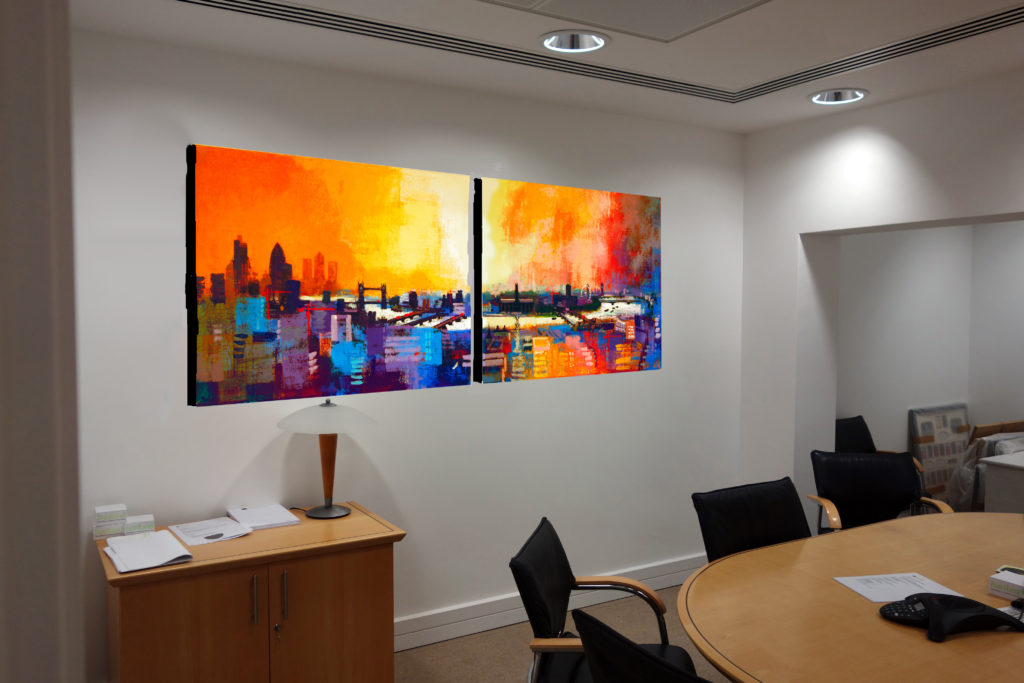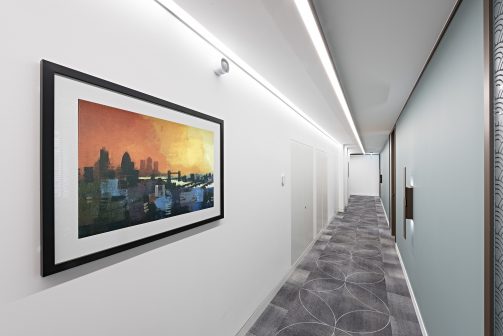CORPORATE ART
‘Corporate’ art is a term for art on show in business premises such as offices, hotels, hospitals, schools, etc.

The difference between corporate art and domestic art is important.
Basically corporate art will be seen in a working environment, and might be chosen by committee or someone else.
Whereas a domestic collector will choose to display art in the privacy of their home where they can enjoy it at leisure.
This is a big difference. But is that all?
Well no. Because there are several other factors.
Motivation.
Corporate art sends a message to the workers and visitors about the business itself. It can be an influence on the people who see it all the time when they are at work. The art says so much about the way the business thinks about itself and their customers. It can be a public relations tool. Rather fewer domestic collectors think like that.
Big or small.
Size is another factor. See my recent blog about small medium or large art here … https://www.artpublish.com/small-medium-or-big-art/
That blog shows how artists have to make a choice about the size of their art. The point is that corporate art is likely to use larger pieces because the environment is bigger. It might be that the artist’s subject matter demands larger artwork. Or it could be that the marketing opportunities, and prospective buyer prospects, persuade you to create big or small for the different audiences.
Costs of showing, hanging, framing, insuring.
The choice to produce for corporate buyers or private collectors has a huge cost implication. Finding corporate customers probably means exhibiting at a trade fair or similar. Showing the art for sale in an exhibition where you pay for wall area is just one example of the costs involved. However the corporate market is much more likely to provide big orders and repeat buyers.
Framing the art is another example. Corporate buyers will want a finished and ready to hang product with good quality frame. A private domestic collector might want to get a frame themselves to fit into their home décor.
Insuring more expensive pieces will have to be negotiated while several smaller pieces could all fit into a smaller cost envelope. So it is going to be much more efficient to create several smaller pieces than one large piece.
That probably means that the better option for an artist’s marketing focus would be onto the direct private collector. The corporate market can come later.
Health and time.
Another point about making large art aimed at corporate buyers is that it takes longer to paint or sculpt. That can mean that the artist has concentrated effort onto one piece rather than several pieces over the same time period. If a larger piece fails to satisfy the artists mind, or fails to find a buyer, then the downside is bigger. A series of smaller pieces can have a mixture of failures and successes, which can be healthier psychologically. There is a bigger risk factor in the corporate market.
Commissioned or not.
The ideal business option for an artist is to be commissioned before starting the artwork. A professional artist operating in the corporate market will want this to be agreed by the customer. A full agreement and deposit is quite usual and business clients will expect and accept it because they have to do that in many other areas of their business operations. The artist should be prepared to discuss this arrangement and have the paperwork ready in advance.
Agent or direct.
If an artist sells their art through an agent they will be expected to create product to cater for the market where the agent is already known. The corporate art buying market is very specific. Exhibition at trade shows is an example. Agencies might be established in this area and so they could be a sensible option for artists.


The agent will certainly influence the artist by encouraging artworks that they can pass on to their client base, or succeed in their chosen market target. Selling through an agent often means that the artist does not get direct valuable feedback from the customer. Instead the input is biased by the agent’s own interests.
But if an artist deals directly with the end customer then they have more flexibility to adapt and develop their range.
Rent or buy.
There are agencies that cater for corporate business clients where they offer the artwork for rent rather than purchase. They have found that many business budgets prefer to spend regularly rather than commit to an upfront payment. The corporate clients also get a chance to return the art after a period of time and take something else. They even seem to be quite happy to pay more in total over time. However the business client will expect continuous attention and maybe a hanging service.
Invest or not.
Private collectors often have a first, second or third motive for buying art. The first might be because they just like art and want to hang it on their walls for pleasure. Secondly they may be saying something about themselves to other people who see their collection. But thirdly they might subconsciously justify these previous motives by seeing their purchase as a sensible investment. People hope that their art collection is growing in value.
But corporate business buyers are less likely to make a buying decision based on an investment hope. This might be because it is often a committee that does the choosing, or they opt to rent and so the art always belongs to the artist or agency.
Conclusion.
If an artist creates primarily for the home environment, and their own creative enjoyment, they are probably not going to have a potential business buyer in mind.
But if the artist makes art aimed at the corporate market then they will produce different artwork, and it might cost a lot more to find their customers.
The artist will have to choose to sell by using an agent and pay a big commission, or spend time and money to sell their art by themselves.




